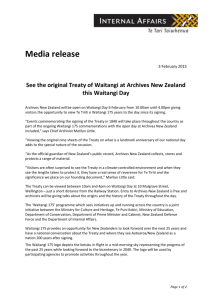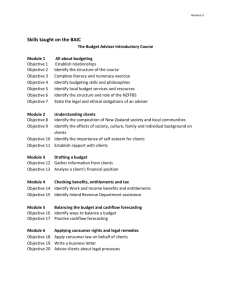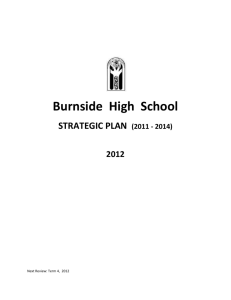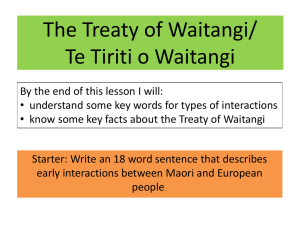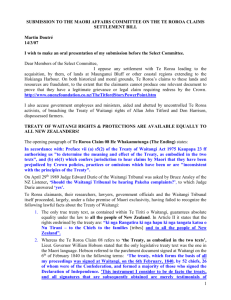Memory of the World Register - Nomination Form
advertisement
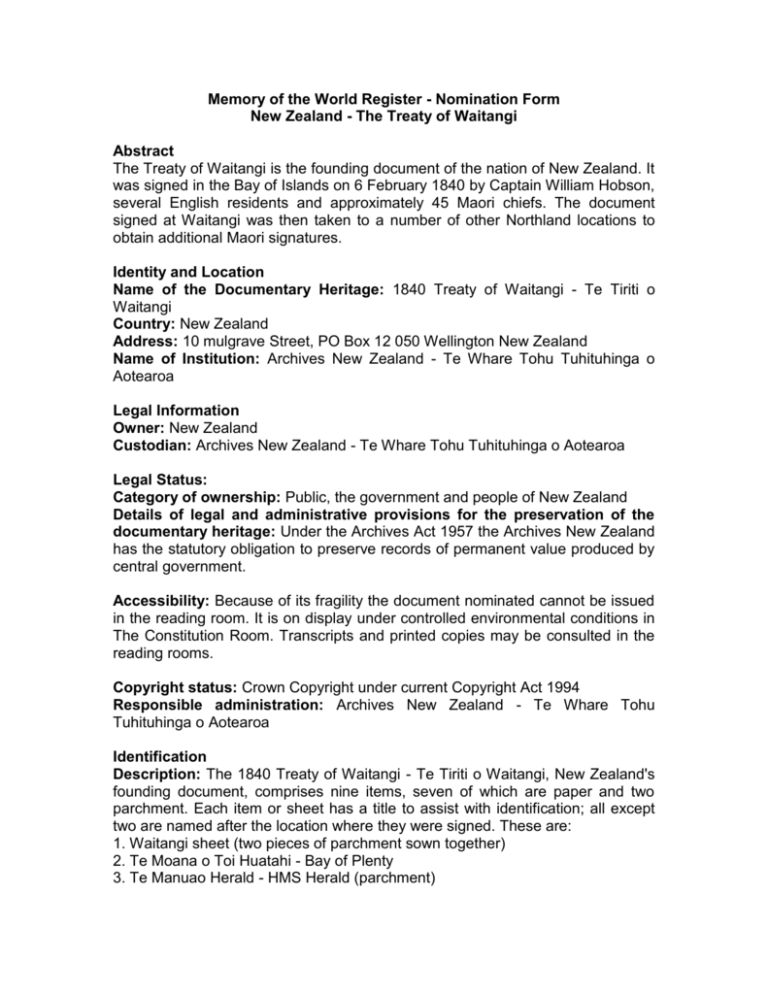
Memory of the World Register - Nomination Form New Zealand - The Treaty of Waitangi Abstract The Treaty of Waitangi is the founding document of the nation of New Zealand. It was signed in the Bay of Islands on 6 February 1840 by Captain William Hobson, several English residents and approximately 45 Maori chiefs. The document signed at Waitangi was then taken to a number of other Northland locations to obtain additional Maori signatures. Identity and Location Name of the Documentary Heritage: 1840 Treaty of Waitangi - Te Tiriti o Waitangi Country: New Zealand Address: 10 mulgrave Street, PO Box 12 050 Wellington New Zealand Name of Institution: Archives New Zealand - Te Whare Tohu Tuhituhinga o Aotearoa Legal Information Owner: New Zealand Custodian: Archives New Zealand - Te Whare Tohu Tuhituhinga o Aotearoa Legal Status: Category of ownership: Public, the government and people of New Zealand Details of legal and administrative provisions for the preservation of the documentary heritage: Under the Archives Act 1957 the Archives New Zealand has the statutory obligation to preserve records of permanent value produced by central government. Accessibility: Because of its fragility the document nominated cannot be issued in the reading room. It is on display under controlled environmental conditions in The Constitution Room. Transcripts and printed copies may be consulted in the reading rooms. Copyright status: Crown Copyright under current Copyright Act 1994 Responsible administration: Archives New Zealand - Te Whare Tohu Tuhituhinga o Aotearoa Identification Description: The 1840 Treaty of Waitangi - Te Tiriti o Waitangi, New Zealand's founding document, comprises nine items, seven of which are paper and two parchment. Each item or sheet has a title to assist with identification; all except two are named after the location where they were signed. These are: 1. Waitangi sheet (two pieces of parchment sown together) 2. Te Moana o Toi Huatahi - Bay of Plenty 3. Te Manuao Herald - HMS Herald (parchment) 4. Raukawa Moana - Cook Strait 5. Rauranga 6. Waikato 7. Te Tai Rawhiti - East Coast 8. Manukay & Kawhia 9. He rau kua ta tuhia - The printed sheet All these sheets are in the Maori language and all have identical text, except for # 6 which is in English. The Waitangi sheet was badly damaged by rodents in the early part of this century, because of bad storage by the government department having custody of the document at that time. Visual documentation: slide/transparencies History: The document was transferred to Archives New Zealand as government record. Bibliography: The best recent publication on the Treaty of Waitangi and its meaning for modern New Zealand is: Claudia Orange, The Treaty of Waitangi. Wellington, Allen & Unwin 1987; reprinted several times. Management Plan Assessment against the Selection Criteria Influence: The Treaty of Waitangi is the founding document of the nation of New Zealand. It was signed in the Bay of Islands on 6 February 1840 by Captain William Hobson, several English residents and approximately 45 Maori chiefs. The document signed at Waitangi was then taken to a number of other Northland locations to obtain additional Maori signatures. To extend the authority of the British Crown over parts of the North Island not covered, plus the South Island, a further seven copies of the Waitangi document were sent around the country for signing. The Church Missionary Society Press at Paihia, near Waitangi, printed copies of the Treaty and one of these also was used to obtain further signatures. Over 500 Maori chiefs signed the Treaty of Waitangi. The Treaty of Waitangi has carried status as the country's founding document through the l9th and 20th centuries to the present. The Treaty of Waitangi is a unique document also because it involved one entire country and one indigenous race. New Zealand is the only modern nation founded on a single treaty between one indigenous race and one metropolitan power. The meaning of the Treaty of Waitangi continues to be subject of much discussion not only regarding the nature and definition of New Zealand, but also in international forums concerning the relationship between indigenous races and modern state powers elsewhere, and the protection of indigenous cultures. Time : At the time it was signed (1840) the Treaty of Waitangi was considered to be a radical departure in treaties between indigenous races and metropolitan powers. It involved just one European power and one indigenous people inhabiting one entire country. It uniquely promised protection of indigenous resources and possessions in the face of colonization and bestowed British citizenship on the original inhabitants of the country. It was used by British and subsequent colonial authorities as a source from which they derived their authority. Subject/Theme: Even though being one of many treaties made between metropolitan powers and indigenous people, the Treaty of Waitangi is a significant departure from most such agreements made at that time. Many similar treaties elsewhere were land cession treaties, but the Treaty of Waitangi was understood by the metropolitan power (England) at the time (1840) as ceding indigenous sovereignty and incorporated promises regarding the protection of indigenous land, fisheries and other rights which were seen as all-embracing and necessary to Maori agreement. Consultation Regional or National Memory of the World Committee: Relevant National Memory of the World Committee Secretary, New Zealand Commission for UNESCO, c/- Ministry of Education, PO Box 1666, Wellington Independent institutions and experts: Dr, Claudia Orange, c/ Dictionary of New Zealand Biography, Department of Internal Affairs, PO Box 805, Wellington, New Zealand Nominator Name: Archives New Zealand - Te Whare Tohu Tubituhinga o Aotearoa Relation to documentary heritage: Custodian Contact Person: Dr Hank Driessen, Manager Outreach Services, Archives New Zealand Contact Details: Archives New Zealand - Te Whare Tohu Tuhituhinga o Aotearoa, PO Box 12 050, Wellington, New Zealand Phone: 04-499 5595 Fax: 04-495 6210 E-mail: han_driessen@mhs.dia.govt.nz national.archives@dia.govt.nz Web: http://www.archives.dia.govt.nz
